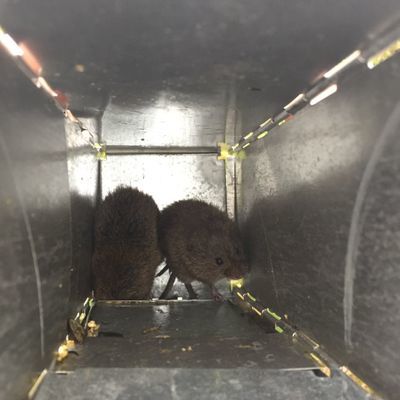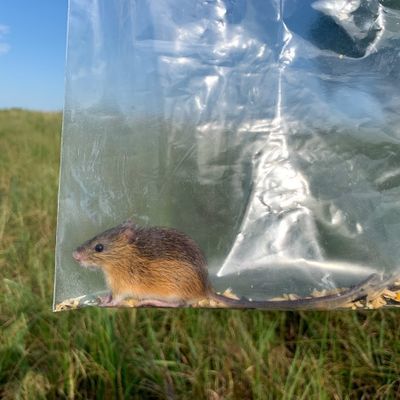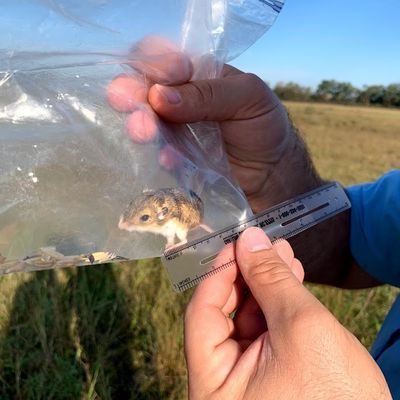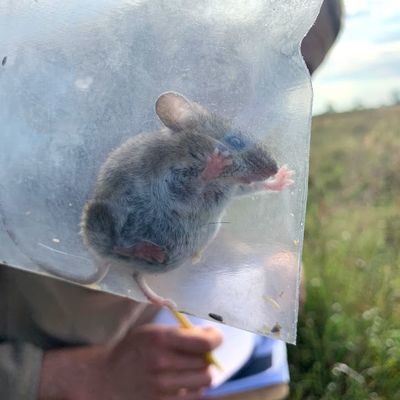
Welcome back!
‘Tiny, but Mighty!’ is the title of this week’s blog post and for good reason! Armed with a ‘can-do’ attitude, two large bags of native plant birdseed mixed with dried mealworms, and four large totes filled with Sherman Box traps (Pictured Below), Jenna Malzahn, Crane Trust’s JR Wildlife Biologist, showed the Lila O. Wilson Intern, Matthew Schaaf, and I the ropes of small mammal trapping at the Crane Trust! While I have worked with Sherman Box traps in previous positions, every organization surveys differently according to the type of small mammals found within the area. Through Jenna’s guidance, the three of us laid out a 200-meter transect in which we set our seed-filled traps every 5-meters. As we did, Jenna explained how the dried mealworm portion of the seed mix, which was unique from my other protocol experience, was used in case a shrew species was caught. Since shrews have a quicker metabolism than the other small mammals, the mealworms provide an extra source of protein which is vital for their survival. The traps are set late in the afternoon and are checked bright and early the next morning to insure they are deployed during the peak small mammal activity period and to minimize the time duration a small mammal is in the trap. Close attention is paid to the weather before each trap night in case the temperature drops too low and cotton needs to be added to the traps as insulation to keep the small mammals safe and warm. Once the traps were set, it was time to play the waiting game to see if our seeds could attract any curious critters!

While we waited I learned the answer to an important question: Why trap small mammals? I learned about how important it is to have an understanding of what species are found around the properties. This list of species allows for the discovery of any new species or the disappearance of any species to be easily detectable. I also learned how small mammals are great indicators of grassland productivity. After learning this, I began to wonder why the Crane Trust samples the same sites every year. Jenna helped answer this by explaining how these sites are revisited in order to get an understanding in the variation in species composition and to also determine if there are any differences in species when different land management techniques are utilized (e.g. bison vs. cattle grazing).
As the sun rose, I couldn’t help but be excited as small mammal surveys are my favorite time of year! My excitement was so overwhelming the first survey morning that I did not even realize the dew soaking my pants all the way above my knee. Regardless, I was ready to venture out and see whether our efforts proved fruitful! While 50 traps may seem like a lot of opportunity to catch small mammals, there are many factors at play and sometimes sites just don’t catch much of anything. This week however, that was not the case! As we moved along the transect, we first check to see whether the trap is open or closed. If the trap is open, we did not catch anything, but we will close it so that nothing can get accidently trapped inside during the rest of the day. If we come upon a closed trap, then we possibly have a small mammal. I learned from Jenna that the trick is to slowly peek open the trap door (Pictured Below) in case the small mammal in the trap decides to try and jump out.

Once a small mammal is confirmed inside the trap, a large plastic Ziploc is placed around the trap opening and the small mammal is gently persuaded into the bag. Now comes my favorite part, identifying! There are several ways to identify to species, including measurements of ear, tail, hindfoot, and body length, coloration differences, and for some small mammals, such as voles, the number of pads on the sole of the hindfoot (i.e. plantar tubercles)! While not all of these pictures were taken this week, check below to see some of the species that have been caught throughout the years on the Crane Trust!




(Top Left: Meadow jumping mouse (Zapus hudsonius). Top Right: Plains pocket mouse (Perognathus flavescens). Bottom Left: (Pregnant) Plains harvest mouse (Reithrodontomys montanus). Bottom Right: Northern short-tailed shrew (Blarina brevicauda))
P.S. While they may look uncomfortable in the plastic bags, I promise this method is imperative for the safety of the research team and the mammals. They are handled quickly and carefully with plenty of oxygen!
To learn more about the small mammals that have been documented on Crane Trust properties and a few of the research articles published by the research team at the Trust, visit this link: https://linktr.ee/cranetrustmammals
Until next time!
Cheers,
Amanda Medaries

